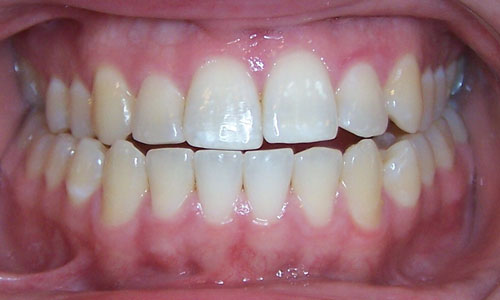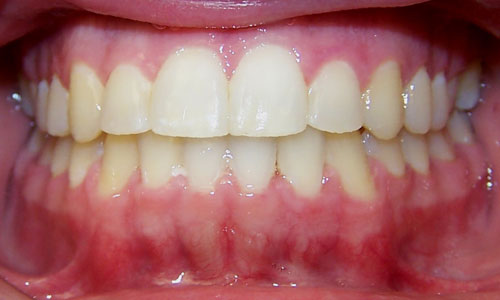HOW FAST IS TOO FAST?
There is no such thing as too fast in orthodontics. Actually, just the opposite is true. If you move teeth too slowly, you expose the teeth to pathophysiological damage. If teeth are responding quickly, they are essentially being properly moved.
Teeth that move slowly are indicating to the orthodontist that the mechanics being applied are “not correct.” Teeth that are responding quickly are indicating that the mechanics being applied are near “optimal.”
HOW MUCH FORCE IS TOO MUCH?
A common misconception is that force magnitude is related to speed. In fact large forces can sometimes reduce speed, and light forces can sometimes increase speed. According to the research produced in the numerous orthodontic journals, force is not really a relevant issue. This generally surprises the reader.
To be thorough, it is important to note that there is such a thing as too strong, but really only when it comes to intrusive (pushing a tooth vertically into the jaw bone) forces.
Proper force magnitudes have been scientifically identified by various research studies. However, the statistics developed from these studies do not apply to all patients. As such, some patients require more/ less force than the statistics would suggest. That is, quality orthodontists monitor tooth movement speed and tooth mobility (looseness) in order to properly calibrate the amount of force that each patient needs. If your orthodontist is “wiggling” your tooth with his fingers, then you know your orthodontist is “calibrating.” If the tooth “wiggles” enough, the force applied is optimal. If the tooth is not “wiggling” enough, the force applied is insufficient. If the tooth is “wiggling” too much, the force applied is excessive.
WHAT IS THE RIGHT SPEED?
As fast as possible is generally the right speed. There are a number of subtleties to that last statement, however. As “fast as possible” doesn’t mean as “strong as possible.” Teeth are not necessarily “jammed” into position, as much as they are “finessed” into position. Sometimes, light forces produce highest speed, and sometimes “heavy” forces produce highest speed. Whatever the force magnitude, in general, as “fast as possible” is the goal.
Why “as fast as possible?” Because slow orthodontics causes problems. See Section What if it takes too long?
WHAT IF IT TAKES TOO LONG?
PROBLEM 1: ROOT RESORPTION & “JIGGLING”
Root resorption is the process of tooth root shortening. It is primarily caused by “jiggling.” Jiggling is a pathophysiological (normal physiology has gone awry) phenomenon. In order to understand jiggling, you must understand normal physiology.
NORMAL PHYSIOLOGY:
Ideally, a tooth should only be moved in one general direction at a time (not back and forth during the day). The tooth moves through the bone by having bone removed on one side (in front of its path) and bone redeposited on the other side (behind its path). This is a process similar to a ship moving through the ocean (water is displaced before the ship, and water is replaced after the ship). Bone removing cells (osteoclasts) and Bone depositing cells (osteoblasts) work together to allow the tooth to “float” through a “sea” of bone.
Bone removing cells remove bone in front of the tooth by releasing acid on the bone in that area. This is where the problem of jiggling starts.
ABNORMAL PHYSIOLOGY: PATHOPHYSIOLOGY
If a tooth does not have enough force applied to it for optimal movement speed, it will sit in the acid produced by the bone removal cells for too long.
Additionally, chewing further confounds the system, because the chewing system causes the tooth to move back and force (jiggle) inside the tooth socket. This produces more than one side of bone-removing acid production around the tooth. In essence, the tooth is inside an bone removing acid broth.
Unfortunately, teeth roots exposed to the bone removing acid for extended periods of time (long orthodontic treatments) tend to dissolve and have short roots. For extremely long orthodontic treatments (3 years or more), root resorption can become quite significant.
Conclusion: Short treatment times are better than long treatment times.
PROBLEM 2: HYGIENE
Braces are wonderful for their benefits. But they also tend to collect plaque, which causes cavities, white spots, and gingivitis.
Conclusion: Short treament tmes are better than long treatment times.
SHOULD I STAY IN BRACES TO STABILIZE MY TEETH?
Braces are designed to move teeth, not stabilize them. Retainers are designed for stabilizing teeth. In general, retainers are worn full time for 3 months for stabilization to occur.
In fact, staying in braces does NOT allow teeth to stabilize, because the teeth are not allowed to settle into the bite due to the orthodontic wire holding them in an “almost perfect” but not “perfect” position. Settling perfects the bite, and it can’t be done while in braces.




